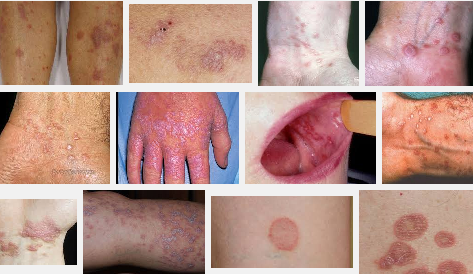Lichen planus
Definition
Lichen planus is a chronic inflammatory condition characterized by recurring episodes of intense itching (pruritus) and distinctive lesions affecting the skin and mucous membranes. While its exact cause remains elusive, certain medications, such as gold or bismuth, have been implicated in triggering this condition. Clinically, lichen planus presents with oral lesions and small, flat-topped papules on the skin, which can progress to form rough, scaly patches. Interestingly, exposure to specific chemicals found in color photograph developing agents can induce similar clinical manifestations. Moreover, prolonged use of quinidine, an antimalarial medication, has been associated with the development of hypertrophic lichen planus, particularly affecting the lower extremities. This highlights the diverse etiological factors and varied clinical presentations of this inflammatory dermatosis.
Symptoms
The onset of lichen planus typically follows a gradual course, with symptoms persisting for weeks to months during the initial phase. While the condition may subside temporarily, recurrences can occur later in life, often manifesting years after the initial onset. Notably, lichen planus is relatively rare among children.
Characteristic of the condition are primary papules, which initially measure 2-4 mm in diameter and exhibit a dark red or violaceous hue. These papules may evolve over time, enlarging into bullae as the disease progresses.
Moderate to severe itching commonly accompanies lichen planus, with lesions often appearing in generalized distribution across the face. Remarkably, these lesions can mimic acne, and new papules may arise at sites of superficial injury, a phenomenon known as Koebner’s phenomenon, which can lead to hyperpigmentation. If left untreated, these hyperpigmented areas may persist, resulting in lifelong chronic patchy scarring.
In addition to skin involvement, lichen planus frequently affects the oral mucosa, with approximately half of patients exhibiting lesions in this area. The buccal mucosa and tongue margins are particularly susceptible, displaying asymptomatic bluish-white linear lesions.
Erosions within the oral cavity are typically painful, and recurrent oral ulcers are a common feature of the disease. These oral manifestations contribute to the overall burden of discomfort and may require targeted management strategies.
Diagnosis
Diagnosing lichen planus typically involves a combination of clinical evaluation and diagnostic tests to confirm the presence of the characteristic lesions and rule out other possible conditions. The most commonly used diagnostic measures for lichen planus include:
- Clinical examination: A thorough examination of the skin, mucous membranes, and nails to identify characteristic lesions, such as violaceous papules, plaques, and erosions, with Wickham striae.
- Biopsy: A skin biopsy is often performed to obtain a tissue sample for histopathological examination. Histopathological features include hyperkeratosis, irregular acanthosis, and a band-like lymphocytic infiltrate in the dermis.
- Direct immunofluorescence (DIF): DIF can help differentiate lichen planus from other conditions by identifying immune deposits along the basement membrane zone.
- Patch testing: Patch testing may be performed to identify potential allergens or irritants that could be triggering or exacerbating lichen planus lesions.
- Oral mucosal swab: In cases of oral lichen planus, a swab of the affected mucosa may be taken for microbial culture to rule out secondary infections.
- Blood tests: Blood tests may be ordered to assess liver function, as some cases of lichen planus may be associated with hepatitis C infection.
These diagnostic measures help clinicians accurately diagnose lichen planus and tailor appropriate treatment plans for affected individuals
Treatment
In most cases, lichen planus presents asymptomatically and resolves spontaneously without the need for treatment.
Upon confirmation of the diagnosis, it is crucial to discontinue any suspected drugs or chemicals immediately.
For cases presenting with moderate itching symptoms, Hydroxyzine 25 mg or chlorpheniramine 4 mg orally four times daily can be administered.
Localized hypertrophic pruritic areas can be treated with a suspension of triamcinolone acetonide diluted with saline (2.5 to 5 mg/ml), which is superficially injected into the lesion to elevate it slightly. Additionally, Triamcinolone acetonide 0.1% cream applied under polyethylene wrapping at bedtime is recommended.
Lichen planus affecting hairless skin can be managed with a combination of tretinoin 0.1% solution and corticosteroids, applied with a cotton-tipped applicator preferably before bedtime. This treatment regimen should be followed by the application of a high-potency corticosteroid cream three times daily.
Pain and discomfort from erosive oral lesions can be alleviated with viscous lidocaine mouthwashes before meals.
For more severe cases with erosive oral lesions and widespread severely pruritic skin lesions, oral prednisone at a dosage of 40 to 60 mg every morning (a systemic corticosteroid) can be prescribed. The daily dosage should be decreased weekly by one-third. However, itching often recurs upon discontinuation of the drug. In such cases, patients may respond to PUVA therapy.
Other treatment options for severe cases include retinoids such as Etretinate and Isotretinoin, Cyclosporine, Cyclophosphamide, and PUVA therapy, which have shown varying degrees of success.
Erosive oral lichen planus may also respond to cyclosporine rinses or oral dapsone.
It is important to note that lichen planus may recur after years, necessitating continued monitoring and management.
Verified by: Dr.Diab (March 30, 2024)
Citation: Dr.Diab. (March 30, 2024). Lichen Planus Definition Symptoms and Treatment. Medcoi Journal of Medicine, 6(2). urn:medcoi:article15561.














There are no comments yet
Or use one of these social networks